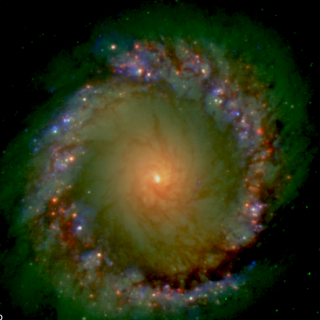Bibcode
Montes, M.; Trujillo, I.; Prieto, M. A.; Acosta-Pulido, J. A.
Referencia bibliográfica
Monthly Notices of the Royal Astronomical Society, Volume 439, Issue 1, p.990-1002
Fecha de publicación:
3
2014
Número de citas
39
Número de citas referidas
36
Descripción
In order to probe the inside-out formation of the most massive galaxies
in the Universe, we have explored the radial (0.1 ≲ R ≲ 8 kpc)
variation of the spectral energy distribution of M87 from UV to IR. For
this purpose, we have combined high-resolution data in 16 different
bands. Our analysis indicate that the age of the stellar population of
M87 remains almost unchanged with radius. However, the metallicity
([Z/H]) profile presents three different zones: the innermost kpc shows
a plateau with supersolar metallicity, followed by a decline in
metallicity down to 5 kpc and another plateau afterwards. The size of
the inner plateau is similar to the expected size (Re) of an
object with the predicted mass of M87 at z = 2. The global [Z/H]
gradient is -0.26 ± 0.10, similar to those found in other nearby
massive ellipticals. The observed change in the stellar population of
M87 is consistent with a rapid formation of the central part (R ≲ 5
kpc) of this galaxy followed by the accretion of the outer regions
through the infall of more metal-poor material.
Proyectos relacionados

Centros de Galaxias a Escalas de Parsecs y Técnicas de Alta Resolución Espacial
Proyecto enfocado al estudio en el IR del núcleo de las galaxias más cercanas con resoluciones espaciales en el rango de 1 a 10 pc. Estas resoluciones espaciales, accesibles con los grandes telescopios de tierra usando técnicas frontera de observación, son por primera vez comparables a las que se obtienen rutinariamente con HST en el óptico y VLBI
Almudena
Prieto Escudero

Huellas de la Formación de las Galaxias: Poblaciones estelares, Dinámica y Morfología
Bienvenida a la página web del g rupo de investigación Traces of Galaxy Formation. Somos un grupo de investigación amplio, diverso y muy activo cuyo objetivo principal es entender la formación de galaxias en el Universo de una manera lo más completa posible. Con el estudio detellado de las poblaciones estelares como bandera, estamos constantemente
Anna
Ferré Mateu